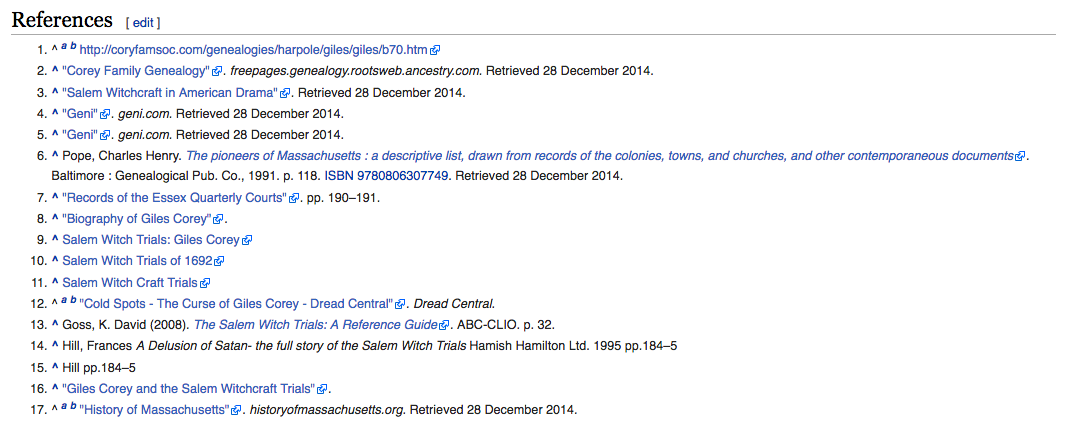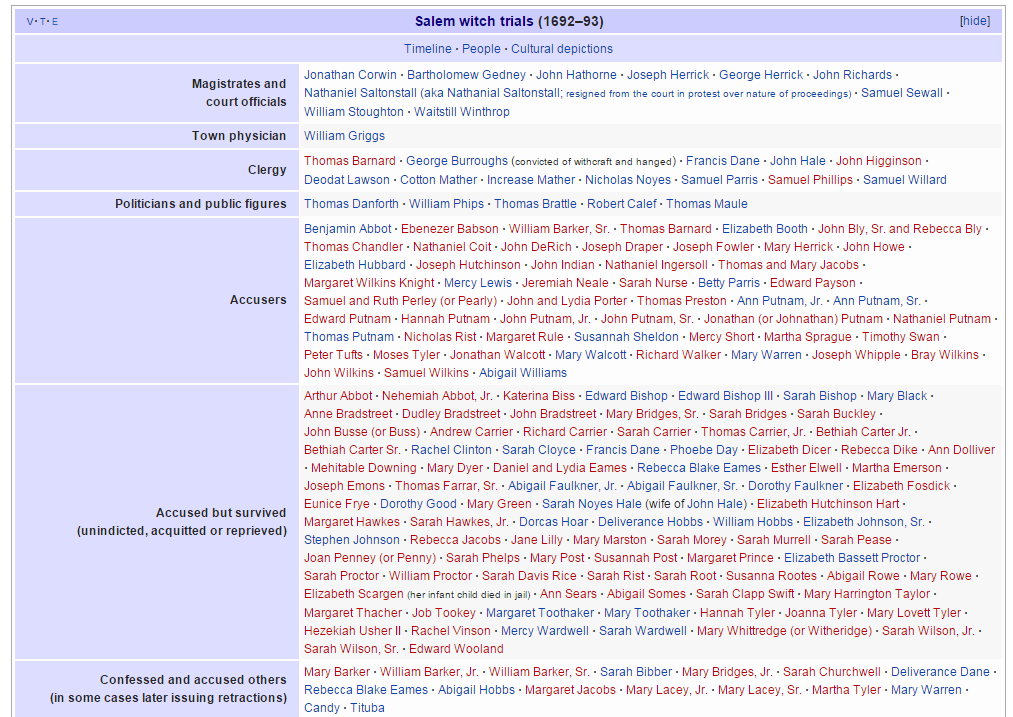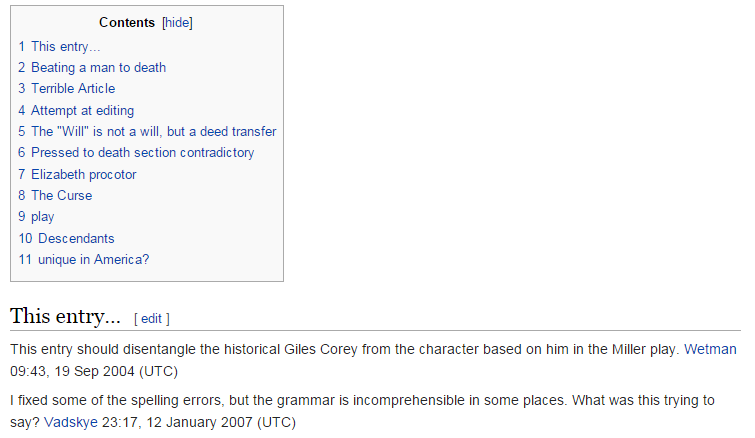Wikipedia, as you probably know, is a massive crowd-sourced encyclopedia of knowledge. Like any other human project, it’s not perfect, but that doesn’t mean it can’t be useful.
This article is here to help you learn some more about tools, some ways Wikipedia can help you learn, and some things you shouldn’t rely on it for. Unlike most of my essays, there will be screenshots. You may wish to pull up the page we’re discussing in another window so you can follow along with the overall structure.

What is it good for? Not good for?
You may have had teachers or professors or other people in your life tell you never to use Wikipedia as a source. I am a librarian by profession (and training! I have a Master’s degree in Library and Information Science), and I use Wikipedia all the time.
What’s the difference? How you use the information.
Wikipedia is an encyclopedia, or what’s sometimes called a tertiary source.
(A primary source is from someone who saw or experienced or was there during an event.
A secondary source discusses primary sources, usually providing more depth and context from a variety of other materials.
A tertiary source provides a summary of different secondary sources, and usually focuses on the facts and details most people knowledgeable about the topic agree on or at least agree are relevant.)
Encyclopedias are a starting point for research, not an end point. That’s true if we’re talking about Encylopedia Britannica or WorldBook (if you remember using their print forms) or specialised topic encyclopedias, and it’s also true of Wikipedia.
I use Wikipedia all the time to help me get started. Some of things I use it for include:
- A sense of when something happened (basic dates/timeline)
- An overview of what happened or someone’s life.
- Other names associated with my subject I might want to research.
- Terms for my topic that I might not know already. (Often a field will have a specific name for something I didn’t know that turns out to be a useful search term for future searches)
- Links to resources about that subject or references to established secondary sources (books, journal articles, etc.)
- A quick resource for variations of names, titles, and other similar information, or for historical background.
It’s also good (depending on the topic, and with some checking) as a way to give people an overview of a subject so you can focus on other parts of an answer or explanation.
I’m not going to talk about editing Wikipedia here, but that’s also an area where if you’re interested, there are lots of options.
Let’s look at an example:
Our example for today is Giles Corey, who is best known for being pressed to death during the Salem Witchcraft Trials in 1692.
While he (and the Salem trials) are not directly related to Paganism in any way, I chose him because his page includes all the elements I want to talk about. There are some common misconceptions about his story and situation, (something true with many topics) but many of the relevant documents are available online or through multiple sources.
These pages have almost certainly changed since I took the screenshots below, and I encourage you to go look at the current pages too. (Most screenshots were taken in March 2016, with a couple in November 2016. Dates are marked.)
What’s on a Wikipedia page:
Here’s a screenshot of the top of the page, showing the overall layout.
If you look at the page, you’ll see a number of different elements.
- There is a sidebar down the left with navigation and important information about the site as a whole.
- There is a search box at the top right of the page, allowing for searches of other topics.
- There are several different tabs across the top of the page: article, talk, read, edit, view history.
- There is a brief summary of the article’s topic followed by a table of contents.
- There is a box on the right with a photograph and some summary information (dates). This is called an infobox. The other text on the main part of the page flows around this box.
- There is a box above the main text that notes that the section needs additional citations, with links for more information.
I should note that many other wikis have some or all of these elements, but how much they get used varies a lot site to site. (MediaWiki, which is the software used to run Wikipedia, is used by many other sites. The Talk and History pages are the ones where you’re most likely to see content.)
Article:
This is what most people think of when they think of Wikipedia: the obvious content you get when you look up a topic.
For most articles of any length, it is common to see a brief introductory section (a paragraph or two) followed by a table of contents. The rest of the article follows. Usually the introductory section is enough to help you make sure you’re looking at the right article for the topic and tell you why this topic is important.
The table of contents is automatically generated from the headings on the page – in this case there are 7 of them. The first four are specific to this article, the last three (References, Further reading, and External Links) are standard headings that appear on many Wikipedia articles as relevant.
Infoboxes:
Many pages on Wikipedia have a sidebar box on the right side of the page with summary or connecting information about the topic. For people, it often includes birth and death dates, links to parents or children if they have Wikipedia pages. For TV shows, it may have links to previous or following seasons, or list the major actors.
For Giles, you can see that it includes an illustration of him being pressed (with a link to further information about pressing), his birth and death dates and age at death, why he’s known, his spouses, children, and parents.
You can see that most of his family aren’t notable enough to have Wikipedia pages of their own, but his third wife, Martha, does. She was executed by hanging three days after he died. (On September 22, 1692.) The whole infobox is a nice quick reference to help you orient yourself to the information on the page.
The next thing you see on the page is a notice about a need for additional citations – we’re going to come back to that.
If you look at the text of the article, you’ll see footnotes in superscript and brackets with links. If you hover over these footnotes, it will give you information about the source, and clicking on it will open that source for you in a new window. Note that this gives additional context for dates and spelling of his name.
The article continues through a number of different headings (this article is about 1800 words long). The first three parts deal with Giles and his background (before the trial), the accusation, and his execution by pressing.
The fourth section is a type that appears on many Wikipedia articles but not all of them, and it sometimes has different names. In this case it is “Legacy” but you may also see “Depictions” or “Media” or other similar headings. By whatever name, this section talks about more recent depictions, relevance to history, or other factors that didn’t take place during the person’s life. If the list of depictions gets very long, it may get its own page (See Cultural Depictions of the Salem Witchcraft Trials for an example)
References:
Wikipedia has specific standards for what they consider to be suitable sources. These standards can sometimes be confusing or overwhelming (the site deals with material from hundreds of countries, many languages, and covers topics with a wide range of variation in documentation, scholarship, currency, and differences of opinion.)
If you’re curious about their standards, you may want to read the Wikipedia page on identifying reliable sources when choosing references. In general, they prefer sources that are available for everyone (open web sites anyone can access, for example) over sources that are only available to some (articles in academic databases or rare and hard to find books.) However, those sources may still be the best source in some cases. The page on citing sources may also be helpful.
Wikipedia also has some special standards for things like currently breaking news, information about living individuals (or people who have just died) and other topics relating to notability and presenting a neutral point of view.
Of course, Wikipedia is written and edited by people, who are flawed (and sometimes biased). Sometimes problems with a page get caught very quickly and fixed. Sometimes things flare up into a lot of back and forth. Sometimes personal issues get in the way of accurate information. Sometimes no one’s sure what the accurate information is.
Take a look at the cited sources and other information I talk about here yourself. (This is why it’s so important to use Wikipedia as your starting point, not your end point.)
In the reference list above, you’ll see that there’s a mix of sources. Some links are to geneaologies. some are to works by academics, some are to works by amateur but thoughtful historians. Many of the sources linked have additional references listed that you could explore further.
(Looking at this reference list, I suspect it’s a little dated, and light on citations to current academic work – A Delusion of Satan is one of the classic works on the Trials, but it came out in 1995, for example, and this article is light on citing more thoroughly researched material. However, it’s still a good starting point, and basic details of what happened and when have not changed in 20 years.)
Further reading and external links:
The final two main sections provide additional resources (not specifically cited in the article but still useful) and links to external sources. In this case, the external link goes to a play about Giles by Henry Wadsworth Longfellow. If the topic of the page is an author, external links may go to public domain copies of their works. In the case of organizations, sometimes a link to their website will be there.
Related pages:
At the bottom of some Wikipedia pages, you may see a table that spans the width of the p age, usually with quite a few links and sections in it. (You can hide this with a link at the top right of the box.) This is another kind of infobox.
In the case of Giles Corey, there are many links identifying other people involved in the Salem Witch Trials, broken up by who they were and how they were involved. The image is a partial screenshot since the table is so big I couldn’t get it to as a single image easily. You’ll notice that many names are in red, which means they don’t have a page on Wikipedia yet.
Categories include
- Magistrates and court officials
- Town Physician
- Clergy
- Politicians and public figures
- Accusers
- Accused but survived
- Confessed and accused others (in some cases there were later retractions or recantations)
- Executed by hanging
- Pressed to death (Giles)
- Born in prison
- Died in prison
- Escaped from custody or otherwise fled Salem or environs until the trials ended
It’s worth noting that some of these lists may be imprecise: different sources give different numbers for how many people died in prison, or died for reasons directly related to the trials, for example. However, it’s still a great way to navigate to related pages more easily.
Another place you’ll see this is many of the mythology pages about specific deities – a number of cultural pantheons have similar boxes that identify other deities from that culture. This is particularly handy if you’re not sure of the spelling or transliteration of a name. For example, the article on Sulis has a table with links to “Ancient deities of Gaul, Britain and Gallaecia by region”
Categories:
The last thing on the page are the page’s categories, normally. This is a way to group pages together, so you can click on a category and find other pages about that thing. Some categories are very straightforward, others are much more complicated or nuanced.
Remember that categories will only show pages that exist on Wikipedia, and have been placed in that category. Since pages need to be added manually, it’s really easy to forget to add one in some cases.
Additional information:
Site notifications:
I mentioned that we’d come back to the content notification. At the beginning of the main article, there’s a notice that says:
This gives links to information about citations and how to improve the article. You’ll see this notice or similar notices if someone has decided the content needs improvement. Usually only removed when people are certain the issue is resolved. You may want to read more about maintenance templates.
History:
If you look back at the top of the page, and those tabs along the top, let’s start with the page history (under the tab that says “View history“)
This page will allow you to compare two different versions of the page over time, to see what things were edited and how. There should be a short (one sentence or so) summary of what edits were made if it’s more than fixing a typo. Information on each edit tells you how much content was changed.
To compare two versions, select the two versions you want to compare, then use the button labelled “Compare selected revisions”. (No screenshot for this one, because it’s a little hard to read that way.)
Talk page:
The last major section we’ll look at is the talk page. The talk page is where comments, questions, and disagreements about the content of the page should live, if it’s something that might improve the page. (i.e. it’s not for general discussion about the topic.)
The top of the page (not shown in the screenshot) often has some general information about talk pages, and then often also information about evaluations of the page, and what might be useful improvements.
The content here varies a lot (if you look at the talk page for Giles you’ll see some very thoughtful comments, and some poorly informed ones or biased ones.) However, I often find the talk page useful if I’m trying to figure out what the big controversies about a topic are, or what specific fringe takes on the topic are.
Wikipedia encourages people who might want to contribute to articles to create an account (so that people can see their activity across the site, which is thought to encourage more responsible editing and help resolve some kinds of issues.)
A few other notes:
You will sometimes come across pages which have limited editing (temporarily or for longer periods of time) usually because there’s a series of edits or vandalism being sorted out. Again, the details of this are beyond the scope of this article, but are a thing you should know happens.
Wikipedia, as noted, is not perfect, being created by humans, but there is a lot of useful information to be gained by checking it, just don’t trust anything without looking in more detail at the cited sources and other resources.

Last edited December 25, 2016. Reformatted November 2020.














